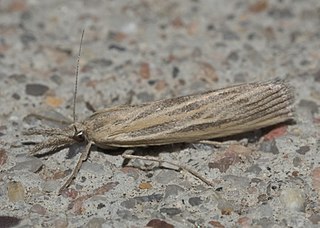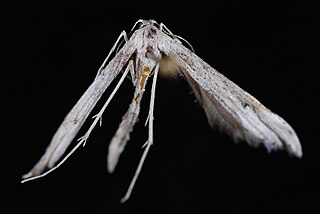
The shark is a moth of the family Noctuidae. The species was first described by Carl Linnaeus in his landmark 1758 10th edition of Systema Naturae.

Apamea crenata, known as the clouded-bordered brindle, is a moth in the family Noctuidae. It is distributed throughout the Palearctic realm. In the North it crosses the Arctic Circle, in the Mediterranean it is found only in cool locations and mountains avoiding very hot areas. In the Alps, it rises to an altitude of about 2000 metres.

Thaumatopsis is a genus of moths of the family Crambidae.

Mesapamea secalis, the common rustic, is a moth of the family Noctuidae. The species was first described by Carl Linnaeus in his 1758 10th edition of Systema Naturae. It is found in Europe, north-west Africa, Turkey and northern Iran.

Agrochola helvola, the flounced chestnut, is a moth of the family Noctuidae. It was first described by Carl Linnaeus in his landmark 1758 10th edition of Systema Naturae. The species is found in most of Europe, north to Scotland and Fennoscandia up to the Arctic Circle, south to Spain, Sicily, Greece further east to the Middle East, Armenia, Asia Minor, western Turkestan and central Asia up to central Siberia.

Oidaematophorus eupatorii, the eupatorium plume moth or Joe Pye plume moth, is a moth of the family Pterophoridae. It is found in North America, including Florida, Mississippi, Iowa, New York, California and Vancouver Island. It is also known from Mexico, Guatemala and Panama.

Oidaematophorus mathewianus is a moth of the family Pterophoridae. It is found in southern Canada and the western part of the United States, eastward in the north to Maine.

Elaphria venustula is a moth of the family Noctuidae. It is found in most of Europe, except the north. In the east, the range extends through the Palearctic to the Pacific Ocean.

The Beautiful Gothic(Leucochlaena oditis) is a Palearctic moth of the family Noctuidae, sub-family Cuculliinae. It is found in southern Europe and north Africa, with occasional finds on the southern coast of England.

Phalonidia lavana, or Platphalonidia lavana, is a species of moth of the family Tortricidae, the subfamily Tortricinae, and the tribe Cochylini. It has a terrestrial habitat and is found throughout North America. It does not have a Global Conservation Status Rank.
Elophila nebulosalis, the nebulous munroessa moth, is a moth in the family Crambidae. It was described by Charles H. Fernald in 1887. It is found in North America, where it has been recorded from South Carolina to Florida.
Crambus multilinellus, the multinellus grass-veneer, is a moth in the family Crambidae. It was described by Charles H. Fernald in 1887. It is found in North America, where it has been recorded from Florida, Georgia, Illinois, Maryland, Minnesota, Mississippi, North Carolina, Ontario and South Carolina.
Thaumatopsis fernaldella is a moth in the family Crambidae. It was described by William D. Kearfott in 1905. It is found in North America, where it has been recorded from Alberta, California, Florida, Maryland, Mississippi, Nevada, New Mexico, Oklahoma, Saskatchewan and Texas. The habitat consists of prairies.
Thaumatopsis magnificus is a moth in the family Crambidae. It was described by Charles H. Fernald in 1891. It is found in North America, where it has been recorded from New Mexico, Arizona and Colorado.
Thaumatopsis pectinifer is a moth in the family Crambidae. It was described by Zeller in 1877. It is found in North America, where it has been recorded from North Dakota to Oklahoma, Texas and southern Florida, as well as Michigan and Indiana.
Leptosteges flavicostella is a moth in the family Crambidae. It was described by Charles H. Fernald in 1887. It is found in North America, where it has been recorded from Florida, South Carolina and Georgia.
Cosipara tricoloralis, the tricolored cosipara moth, is a moth in the family Crambidae. It was described by Harrison Gray Dyar Jr. in 1904. It is found in North America, where it has been recorded from British Columbia, California, Colorado, Montana, Oregon and Washington.

Diasemiodes nigralis is a moth in the family Crambidae. It was described by Charles H. Fernald in 1892. It is found in North America, where it has been recorded from Florida to Texas, with strays north to at least Michigan and Maryland.

Elaphria chalcedonia, the chalcedony midget moth, is a moth of the family Noctuidae. It is found in North America, where it has been recorded from the eastern United States, from Maine to Florida, west to Texas and north to Wisconsin. It is also found in Jamaica, Guadeloupe, Saint Martin, Puerto Rico and Central America. It was described by Jacob Hübner in 1808.

Sciota uvinella, the sweetgum leafroller moth, is a species of snout moth in the genus Sciota. It was described by Ragonot in 1887. It is found in North America, where it has been recorded from New Jersey to Florida, west to Texas and Kentucky.












